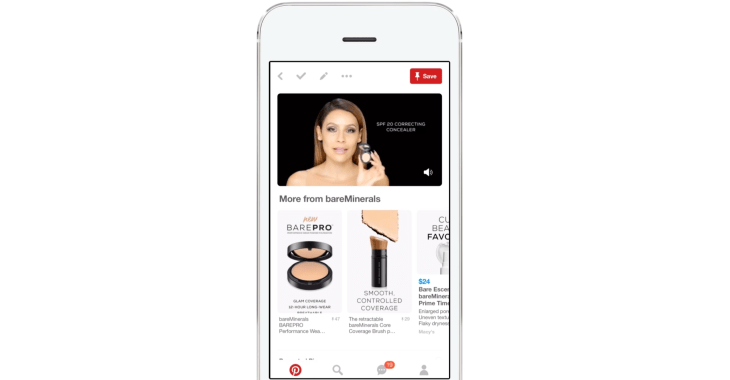Advertisers have plenty of options for running video ads — but they haven’t had a chance to run on one of the most engaging discovery-driven platforms on the Internet, Pinterest, quite yet.
That’s partly because the option simply wasn’t there on Pinterest. It was only in the past few weeks that the company finally started rolling out a native video player. And it was natural that video-based advertising would follow, which the company is now rolling out with its managed partners. It won’t be completely open to the rest of its advertising customers yet, as is often the case with the new products it rolls out.
Pinterest advertisers are going to get access to all the traditional metrics they can follow when they buy a video advertisement. They’ll also have the option of sticking a few featured pins below the video, which Pinterest is currently giving away for free for advertisers running video campaigns. While 75% of the content on Pinterest comes from businesses, that still has to be owned by the business that’s featuring it below a video — though if those businesses are already advertising on Pinterest, that should be easy to find.
There’s a good reason for that kind of placement. There have been plenty of attempts at monetizing the content of videos explaining how to use products — such as trying to cater to influencer marketing — and Pinterest offers a more direct channel for those marketers. By advertising using video on Pinterest, businesses can directly funnel users from the discovery experience of viewing a video directly to a point of conversion.
That’s part of Pinterest’s edge with advertisers. Pinterest users come in to the service from all points of the purchasing lifetime — from simply wandering around and discovering products, to searching for them, to logging them directly and then eventually purchasing them. Other platforms have access to different touch points, but Pinterest has the ability to follow a user across all those points to an eventual conversion (including on Pinterest itself with the buy button).
“We’re supporting all the traditional metrics for advertisers, but because we actually have a slightly different format, that’s some of the stuff we’re actually adding to it,” Pinterest ads product manager Mike Bidgoli (who joined from the company’s acquisition of Tote) said. “[Advertisers] wanted us to basically come up with video and have that twist in it, and we believe the featured pins idea is the core execution of that.”
Pinterest’s video ad products won’t be restricted to a specific kind of format, and will work with multiple dimensions, Bidgoli said. Historically, longer pins have tended to do well on the site, Bidgoli said. But the final version is something that is going to be best suited to the product advertised — a movie trailer might be best suited sitting next to other featured trailers, while a product tutorial might be best suited sitting above other products.
This isn’t Pinterest’s first take on video advertising. Before diving into video, more generally speaking, Pinterest experimented with a format called Cinematic Pins — where short videos would essentially play tied to the scrolling of the page. This wasn’t entirely uninformed: users are often quickly skimming back and forth through videos rather than watching them fully, and that’s held true for the native video that Pinterest has started to roll out, Bidgoli said.
For now, an advertising product like this makes sense to sit with Pinterest’s advertising partners while the kinks (and preferred user behavior) are worked out. But such a product also fits nicely with a lot of other areas where popular online personalities can find ways to slip advertisements for products into their videos. Pinterest’s video advertising option gives advertisers — once it’s available — the option of dropping products right in the sightline of viewers, which could be effective across a broader array of content.
Native video is still a new play for Pinterest, but it’s an area that shows a lot of promise for the company. A lot of the tools Pinterest has built for its visual discovery engine — which allows it to essentially discover products within frames — is somewhat applicable to video if it’s running within Pinterest’s confines. While Pinterest users have had to make due with sharing video from other platforms thus far, it seems natural that the same kind of expectations that Pinterest users have (and will have) for photos will eventually apply to video.
